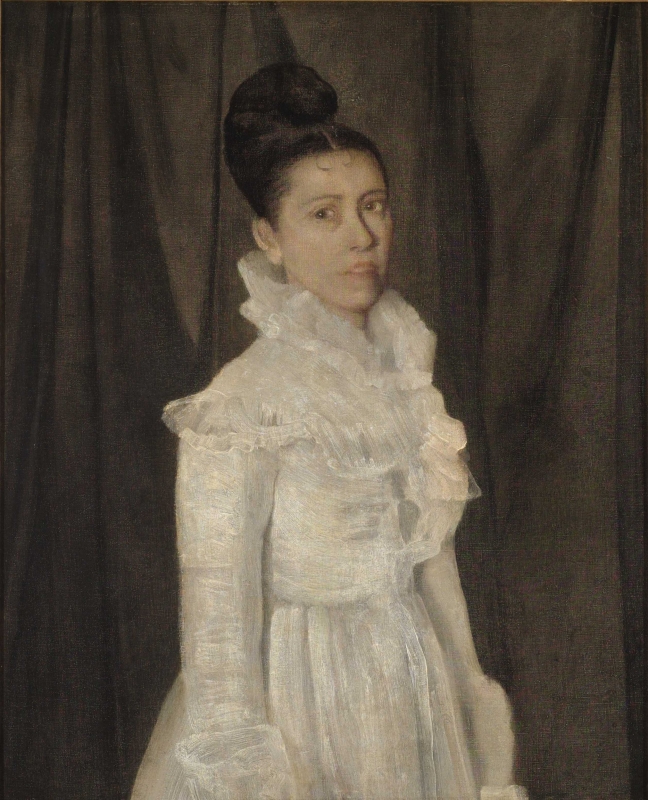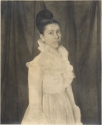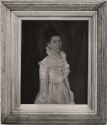Home > Catalogue > Browse > Young woman in a white dress << >>
Composition
Technical examination, including X-rays and old photographs, and the recent surveys using infrared and X-ray imaging and X-ray fluorescence spectrography, show that the figure of a woman in white was painted over at least two earlier compositions. One showed a woman in a white dress with sloping shoulders and a small, pointed collar. Underneath this, there appears to be a woman in a pink and white dress, possibly with epaulettes or puffs at her shoulders, a bow or rose at right, big bows or bustle at the back of her skirt, and a small round object at the front of her skirt. It is possible that the face was a later addition, the original head having been rubbed out.
Technique
The picture is painted on a plain weave canvas and is lined with a courser plain weave canvas. The lower edge appears to have been cut, so that the portrait may originally have been a three-quarter or full-length portrait, which was damaged and repainted.
The canvas was prepared with at least two ground layers, one white, and secondly a broadly painted greyish/yellow imprimatura in which the elements barium (Ba) and strontium (Sr) are present. 1
It was thinly painted, and there are numerous signs of pentimenti, and indeed there may have been two or three totally different positions of the figure and designs of the dress, though which of these were done by the artist or later restorers is not known. The skirt appears to have been wider, possibly with a bow or bustle. The woman's right arm appears as a solid, bolster-like object. The thinly painted areas of around the neck and bust (possibly a collar, ruffled trimming, a fichu or scarf) are painted much more delicately and freely, but are difficult to interpret because they appear to belong to different stages of the portrait or, indeed, to different portraits.
The painting, as it stands, has been rubbed and scraped down, by an unknown hand or hands, and may have been unfinished.
Conservation History
It was restored in London in 1910, possibly in the USA in the 1940s, and certainly restored and retouched extensively in the Netherlands by the conservator Gwendolyn Boevé-Jones in 2015.
On 15 September 1910 the London art dealer Walter Dowdeswell (1858-1929) took Whistler's biographers, Elizabeth Robins Pennell (1855-1936) and Joseph Pennell (1860-1926), to visit a man 'in a remote part of Camden Town, who is restoring a few [paintings]', and showed them this unsigned portrait. 2
Research carried out on behalf of the Laren Museum by Elsemieke van Rietschoten, under the supervision of Dr Arjan de Koomen and Professor Arie Wallert, was presented in her thesis, A ghost of a portrait. Authenticating Symphony in White. Girl in muslin dress. This covers the 1910-1911 history of the painting, and gives an account of the technical research undertaken by Professor Wallert, naturally relying on his conclusions. 3 She comments that 'During the recent restoration previous overpaintings have been removed. The frill at the front of the dress is perhaps the most notable difference between before and after restoration. Furthermore restoration revealed additional small curls at the forehead of the woman, which significantly changed the woman's hair style. It appears that in the past the picture was altered to look more like a Whistler.' 4
Recent conservation includes removing a dark curtain behind the figure, and reveals that the dress may have been partly pink. The face has also been restored recently, the conservator taking care to repaint areas that were bare canvas. The Singer Museum website states:
'Eén van de hoogtepunten bij de opening van Singer Laren in 1956 was het schilderij Symphony in white. The Girl in the muslin Dress van James Abbott McNeill Whistler (1834-1903). Ruim twintig jaar geleden werd de authenticiteit van het schilderij betwijfeld. Sindsdien is het niet meer te zien geweest. Singer Laren heeft het schilderij laten onderzoeken en dit kunsthistorisch en materiaal-technisch onderzoek toont aan dat het doek wel degelijk van de hand van Whistler is. In de tentoonstelling De hand van Whistler, ... 2016, wordt het proces van authenticatie en restauratie in beeld gebracht'. 5
This translates as ‘One of the high points of the opening of the Singer Laren in 1956 was the painting Symphony in white. The Girl in the muslin Dress by James Abbott McNeill Whistler' (actually it was shown as 'Dames-portret'). The Laren website adds: 'About twenty years ago the authenticity of the painting was regarded as doubtful. Since then it has not been on display. Singer Laren had the painting investigated and this art historical and scientific research showed that the painting was reliably painted by the hand of Whistler. In the exhibition The hand of Whistler [in] 2016, the process of authentication and restoration is depicted.'
The Director of the museum, Rudolph de Lorm, is quoted in a newspaper article as saying:
' “Na uitgebreid modern materiaal- technisch onderzoek zijn wij er van overtuigd dat het damesportret Symphony in White. Girl in muslin dress uit circa 1870 een schilderij van Whistler is … Nederland heeft er een tweede Whistler bij." '
(Translation:) ' “After extensive modern material-technical research we are convinced that the portrait of a woman Symphony in White. Girl in a muslin dress from circa 1870 is a painting by Whistler … The Netherlands has acquired a second Whistler" ' (the first being Arrangement in Yellow and Grey: Effie Deans [YMSM 183], which is in the Rijksmuseum).
In a documentary published in AVROTROS on 11 October 2016, the Director commented: “Ik had het schilderij wel eens zien staan, en de blik van de vrouw liet me niet los,” (“I had once seen the painting on display, and the glance of the woman never let me go"). He consulted the technical art-historian Professor Arie Wallert at the University of Amsterdam, who had conducted research on the Rijksmuseum painting. The results, according to the Director were as follows:
' "En uit röntgen- en infraroodonderzoek bleek dat in de Rijksmuseum-Whistler en in de Singer Museum-Whistler met precies dezelfde stoffen geschilderd zijn. Zo bevatte de grondlaag zeldzaam radioactief strontium. Ook bleek in de verfstreken Whistlers hand herkenbaar. Het doek ... bleek deels overschilderd bij restauraties. Op basis van alle onderzoek schrijft Singer Laren het ongesigneerde doek nu toe aan Whistler. " '
Translation: ' "From X-ray and infrared analyses, it appeared that the Rijksmuseum Whistler and the Singer Museum Whistler were painted with exactly the same materials. For example, the base layer contained rare radioactive strontium. Whistler’s hand also seemed to be recognizable in the strokes of paint. The painting ... appears to have been partly painted over during restoration. Based on all the research Singer Laren attributes the unsigned painting to Whistler." '
Elsemieke van Rietshoten, in her MA thesis, clarifies this point:
'Celestine – a mineral consisting of strontium sulphate (SrSO4) – was identified as a possible material marker. XRF analysis consistently showed the presence of strontium (Sr) within the painting. The use of celestine as a pigment appears to be characteristic for the works of Whistler. Erma Hermens and Arie Wallert conclusively proved the use of celestine in Arrangement in Yellow and Grey: Effy [sic] Deans (Rijksmuseum, Amsterdam). It is the only recorded occurrence of the mineral as a pigment in easel painting. According to Hermens and Wallert the presence of celestine in the Effy Deans might be related to the use of Orr Duresco house paint, a lithophone mixture (ZnS·BaSO4) with added celestine.' 6
However, Elsemieke van Rietschoten concludes:
'Technical analysis could not prove beyond doubt if Whistler did, or did not painted the picture. It revealed characteristics that conform [to] Whistler’s painting technique, as well as aspects that differ. The presence of celestine would have been an important facet in authenticating the picture. However, barium sulfate was used instead. The use of a grey priming conforms with Whistler’s usual practice. However in this case charcoal black is used instead of the ivory black Whistler typically used. … It could not be determined if the curtain was added later. However, the difference in finish between the face, dress and curtain seem to suggest the painting is unfinished and possibly partly overpainted. The picture seemed to be altered considerately during previous restorations. It appears to be reduced in size and at one point the woman wore a pink rose on her dress. A butterfly signature was added – and later removed – to make the picture look more like an authentic Whistler. Human interference appears to have drastically altered the appearance of the picture. It is difficult to distinguish between the original picture and possible later additions.' 7
Unfortunately no further research was done at the time on behalf of the Laren Museum to compare the use of barium sulphate in the base layer with other paintings by Whistler or by his contemporaries. Nor was it clear, from the investigation and restoration undertaken in preparation for the exhibition at Laren, which of the numerous variations in technique and composition was identified as what the Director describes as 'Whistlers hand', although Elsemieke van Rietschoten does mention that 'The original dress was painted with a broad brush. The paint is applied in free brushstrokes not unlike the brushwork in the portrait of Cicely Alexander.' 8
Questions about the authorship of this work were discussed in the New York Times by Nina Siegal on 15 October 2015. The possibility that it was among paintings destroyed at the time of Whistler's bankruptcy was mentioned:
'Officials at the Singer Laren ... say that its painting “Symphony in White: The Girl in the Muslin Dress” was most likely one of those works, rolled up and damaged and then heavily repainted by a clumsy restorer. Last week, the museum’s director and affiliated experts here reclaimed the painting as an authentic Whistler ... challenging a leading Whistler authority who had discredited the work about two decades ago.
“We have our Whistler back,” the director, Jan Rudolph de Lorm, said at the museum on Monday. “It is clear that if you look at the proof, both the pedigree proof and the underlying images, it’s enough for us to say it was our Whistler.”
The tale of how officials at a small museum in the Netherlands came to claim an authentic Whistler illustrates the way new technologies are allowing museums to tackle attribution issues when works of art are called into question. In the past, the word of top scholars was often enough to authenticate or discredit a work, sometimes robbing an art institution of prestige. But with new scientific methods and independent scholarship, museums are now vying to assert the value of their own treasures.
The Whistler attribution here is based on new scientific and art-historical research conducted by the museum over the past two years, in collaboration with art historians and specialists in painting analysis from the Rijksmuseum, the University of Amsterdam and the University of Antwerp. Using tools like infrared and X-ray imaging and X-ray fluorescence spectrography, they were able to more precisely date the work and explain how and where it was subsequently repainted.
If it is indeed a genuine Whistler – which is still in dispute – that would bring to two the number of Whistler paintings in the Netherlands’ collections. The other is the Rijksmuseum’s full-length portrait “Arrangement in Yellow and Gray,” known informally as “Effie Deans,” ...
Both paintings are on display in a one-room Whistler exhibition at the Singer Laren, ... In addition … the museum is displaying several prints of X-ray scans of the “Muslin Dress” painting and a documentary about the findings, “to make the research transparent” Mr. de Lorm said. ...
... [O]n the market to 1910, when it was seen, with other Whistler works, at the shop of the London art dealer Dowdeswell ... [by E. R. & J. Pennell] ... They noted ... that the curtains were “rather elaborately finished” while the figure was “not carried very far”—a suggestion that someone else may have tried to complete an unfinished painting. ... [In] 1949 there are records of Dowdeswell offering it to the Springfield Museum of Fine Arts in Massachusetts, which did its own X-ray of the painting. They questioned its authenticity, and turned it down. ...
[In] 1997 ... according to Mr. de Lorm, a leading Whistler authority, the University of Glasgow professor Margaret MacDonald, author [actually co-author] of the 1980 catalogue raisonné of the artist, visited the museum and cast doubt on its authenticity. ...“When Margaret MacDonald was hesitant, the Singer made a stupid move,” said Arie Wallert, a professor of technical art history at the University of Amsterdam, one of the leaders of the research project. “They dis-attributed the painting and put it in storage, and almost forgot about it.”
It wasn’t until 2009, when Mr. de Lorm, former head of exhibitions at the Rijksmuseum, was hired as the new director of the Singer Laren, that someone took notice. After seeing the painting in the depot, he looked up its inventory card, which showed that the insurance value of the painting was 300,000 guilders in the 1990s and after Ms. MacDonald’s visit, it was decreased to 3,000 guilders.
“I was angry,” he said. “I couldn’t really understand why they would be so fast in diminishing one of the crown jewels of their collection.” Ms. MacDonald, who is currently working on the Whistler catalogue raisonné, which hasn’t been updated since 1980, said she wasn’t the only scholar who was uncertain about the work.
“I’m one of several people who have cast doubt on the image,” she said in a phone interview, citing the co-authors of the catalogue raisonné, the late Whistler authority Andrew McLaren Young and Robin Spencer. “We’ve got records at the University of Glasgow going back to the 1940s and they do cast doubt on the evidence at the time.”
Mr. de Lorm initiated the new research with the help of Mr. Wallert, who had been a colleague at the Rijksmuseum. They tested paint samples to compare the work with the Rijksmuseum’s painting, did modern X-ray fluorescence scans and revealed interesting new information. After removing the darkened varnish, for example, the restorers found that the curtains behind the figure were painted at a later date, probably by a restorer. Also, it was found to be cut down, and was likely originally a full-length portrait, Mr. Wallert said.
“It’s a very over-painted Whistler and a very damaged Whistler,” he concluded. “But I don’t have any doubts that what we have here is a decent Whistler.”
Erma Hermens, a technical art history professor at the University of Glasgow, on the other hand, doesn’t see it as such a straightforward case. “To be totally conclusive is very, very difficult,” she said in a phone interview. “There’s a gap in the history, where this painting traveled to or where it was kept.”
Ms. MacDonald also said she isn’t convinced. “I saw it a couple of weeks ago and I felt I still needed to do more research,” she said. For example, she still wants to date the hairstyle and the dress, and compare the painting to a work of the same period, “Harmony in White and Blue,” at the Leeds Art Gallery in Britain.
But Mr. de Lorm is confident: “We believe in what we’re presenting now, and now the ball can go to the next player, and we will follow it and participate.”
He said the museum’s work on this painting would help Whistler scholars learn more about the painter’s bankruptcy period. “I hope our research is a start to look again at this whole group of paintings from Whistler’s oeuvre.” ' 9
Unfortunately, the results of the technical research carried out for Laren Museum were not conclusive; they were in fact incomplete. They were not, for instance, compared with other, possibly comparable, paintings by Whistler and his contemporaries (Walter Greaves, for instance). Furthermore, it is not known if the results of the technical survey reflect the work of an artist or a tradesman preparing a canvas for painting or selling. They did not give reasons for the date of 1870 for the painting, except to imply that it dated from before Whistler's bankruptcy.
Elsemieke concludes:
'The condition of the painting makes it difficult to understand it. The picture appears to be altered extensively by human interference. It is not always possible to distinguish between intentional alterations and later overpainting. Reconstructing the original picture asks for some imagination. The difference between authentication and authenticity linguistically is but minor, however in attribution it can make a big difference.' 10
It remains uncertain whether Whistler could have had any part in this painting, and if he did, whether any of it is visible.
Frame
Grau-style frame, ca 1910.
Notes:
1: Elsemieke van Rietschoten, A ghost of a portrait. Authenticating Symphony in White. Girl in muslin dress, MA thesis, University of Amsterdam, July 2017, pp. 30-31.
2: Pennell 1921C [more], pp. 127-29.
3: van Rietschoten, Elsemieke, A ghost of a portrait. Authenticating Symphony in White. Girl in muslin dress, MA thesis, University of Amsterdam, July 2017.
4: Ibid, p. 38.
5: Website at http://www.singerlaren.nl/whistler. On 11 October 201 a documentary was broadcast relating to the research.
6: van Rietschoten, Elsemieke, A ghost of a portrait. Authenticating Symphony in White. Girl in muslin dress, MA thesis, University of Amsterdam, July 2017, pp. 24-25, citing Hermens, Erma, and Arie Wallert, 'James McNeill Whistler: Fluidity, Finish and Experiment', in Spring, Marika, and Helen Howard (eds), Studying Old Master Paintings: Technology and Practice: the National Gallery Technical Bulletin 30th Anniversary Conference Postprints, London, 2011, pp. 229-236.
7: Ibid., p. 39.
8: Ibid.
9: New York Times website at http://www.nytimes.com.
10: van Rietschoten, Elsemieke, A ghost of a portrait. Authenticating Symphony in White. Girl in muslin dress, MA thesis, University of Amsterdam, July 2017, p. 50.
Last updated: 20th April 2021 by Margaret








